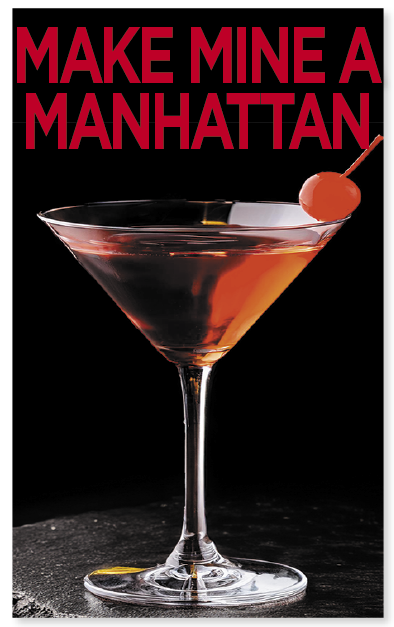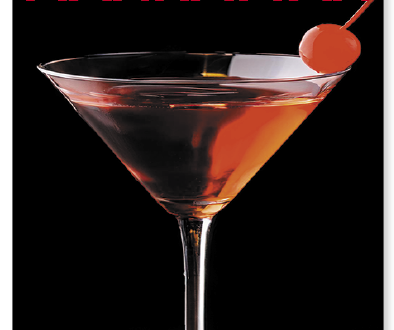MAKE MINE A MANHATTAN
 By Kirsten Amann
By Kirsten Amann
The holiday season is now behind us and while a good percentage of the population embarks on their “New Year, New You” resolutions and Dry January, I will ignore this trend and reach for something stronger. I wholeheartedly support the “no and low” served movement but I am not part of it, not this winter anyway. Times are tough, the days are cold and dark, and I plan to lean into winter’s chill with a drink that has warmed my family for generations: a Manhattan. In other words, New Year, Same Me.
The Manhattan is a foundational cocktail that has a long history throughout which it has pretty much retained its primordial structure, unlike many of its 19th century contemporaries. By the time I learned about these drinks in the late 1990s, Old Fashioneds had devolved into a mess of muddled oranges, whiskey sours had morphed into something made with mix from a soda gun, daiquiris were frozen, and so on. For whatever reason, for over 150 years, when it came to the Manhattan, bartenders were content to leave well enough alone.
What I loved early on about Manhattans was that ordering, or taking an order for one, felt a special code between server/bartender and guest. Even back then, when bars didn’t have fresh juice and a bar spoon was seen as mostly superfluous, if a guest ordered a Manhattan, the bartender would snap to attention before launching into a series of questions: what type of whiskey? Up or on the rocks? Twist or cherry? And sometimes they’d receive my absolute favorite cocktail instruction, to “make it perfect.” The Manhattan, like the Martini, is a tailored creation, and one that I’ve found even the most glib of bartenders to take seriously. It would be many years before I began to study the rich history of the libations and foodways that make our American drinking culture so unique, but the Manhattan was enough to pique my curiosity way back when.
ORIGIN STORY
The Manhattan’s backstory is murky, debatable, and once you get deep into those weeds, perhaps not very interesting to the common reader. Its most oft repeated origin story, featuring Winston Churchill’s mother, is not true. That piece of fiction takes place at the Manhattan Club in New York circa 1874. And as the story goes, the drink was invented at the directive of Jennie Jerome (Winston’s mum) to be a special signature cocktail at a reception she was hosting to honor recently elected governor of New York, Samuel J. Tilden. Author and cocktail historian David Wondrich recounts in his cocktail history tome IMBIBE! “This story, one of the most widely propagated of all drink myths, could hold up, except for the fact that the inaugural celebrations happened to coincide with Lady Winston’s delivery and christening of baby Winston — in Oxfordshire. And no, he wasn’t christened with Manhattan Cocktails.” It’s fake news, but a story I’ll probably continue to tell and then immediately debunk, if only to repeat that joke.
Many experts think the Manhattan was nevertheless created at the Manhattan Club, a fashionable private club during the 19th century heyday of gentleman’s social clubs in New York. It was known, as many clubs were, for excellent food, drink and of course, cocktails. The Manhattan Club in particular was created as a gathering spot for New York Democrats after the Civil War. Those Democrats were not the same as today’s Democrats: they who supported secession in the South and “a more agricultural economy that suited Southern planters and the Peculiar Institution — a polite euphemism for slavery,” explains Philip Greene in The Manhattan: The Story of the First Modern Cocktail. “The Democratic Party lay in ruins, but New York City Dems still had the wherewithal to establish a social club that year [in 1865],” writes Greene. It was founded at the fashionable restaurant Delmonico’s
and moved to the Benkard Mansion at 96th Fifth Avenue in 1866, dubbed ‘No. 96’ by its members. As Green writes, “Both its bar and its bartender, John F. Irish, also had an excellent reputation.”
The Manhattan makes its print debut in 1882, in the OLEAN DEMOCRAT, a paper from upstate New York: “It is but a short time ago that a mixture of whiskey, vermouth, and bitters came into vogue. It went under various names: Manhattan cocktail, Turf Club cocktail, and Jockey Club cocktail,” the piece states. The Manhattan Club was not the only club in town, though, and this was the era of club drinking: perhaps the recipe made the rounds to all the fashionable clubs in town, each of whom claimed the concoction as their own? Or perhaps the drink was invented at the Manhattan Inn? David Wondrich shares another story with an interesting archival trail, which states the drink was invented by “a man named Black who kept a place 10 doors below Houston St on Broadway in the sixties.” William F. Mulhall, a bartender from the famous Hoffman House from 1882-1915, told this to a reporter in 1922. The details, from the timing to the precise location, are off, writes Wondrich: “While the only Black city directories have running a saloon during the 1860s was one John Black, who kept a bar at 130th Street, if we look to the next decade they show three Blacks running saloons, including — and here things start to get interesting — a George Black operating a saloon at 493 Broadway, below Houston, from 1874 until his death in 1881.” George’s saloon was called the Manhattan Inn.
While we’ll never know the truth about the Manhattan’s original progenitor, modern sources agree that the Manhattan was born in New York, although mentions of the cocktail abound in newspapers far and wide, because the drink quickly became a hit.
THE FIRST “MODERN” COCKTAIL
I typically consider “modern” drinks libations invented in this century, specifically cocktails developed in the ‘aughts and 2010s at the great bars of this generation that have since spread far and wide, such as the Penicillin or Paper Plane. Philip Greene’s take is that modernity started much earlier, with the Manhattan: “No other drink can match the historical and cultural significance of the classic cocktail, the Manhattan,” writes Greene. “Its advent represents a watershed moment in cocktail history.”
Today the term “cocktail” encompasses pretty much any mixed drink made with alcohol (or perhaps without even that if you’re making ‘spirit free’ libations or mocktails for ‘dry January’) but in the beginning, a cocktail was a specific formula. There were other categories of drinks being served at the 19th century bar, like punches, collins, fizzes, sours, coolers, toddies, slings, juleps, sangarees and so on. The first printed reference and specific recipe for the drink called the “cocktail” appeared in THE BALANCE AND COLUMBIAN REPOSITORY of Hudson, New York on May 13, 1806, describing “a stimulating liquor, composed of spirits of any kind, sugar, water, and bitters — it is vulgarly called a bittered sling.” For many decades the ‘bittered sling’ would stay just that, a strong formula meant to season its base spirit with dashes and drops of other things. All of that would change once American bartenders got their hands on vermouth.
By the 1840s, both Italian (sweet) and French (dry) vermouth had made their way across the pond to the United States: “The precursor to Martini & Rossi may have tried as early as 1836 and Noilly Prat was shipping its dry vermouth to New Orleans in 1851 and San Francisco in 1853,” writes Wondrich. Ads for vermouth appeared in gold country, enterprising Italian immigrants who made wine on the west coast worked up domestic versions, and vermouth eventually appears on the wine list of Delmonico’s and posh hotels. But when it dawned on American bartenders to splash vermouth into a cocktail, it took off. “Once people noticed vermouth and began poking at it,” Wondrich writes, “it was inevitable that sooner or later somebody was going to try to make a cocktail out of it.” Then as now, a bartender loves a new ingredient.
First, vermouth got its own treatment, and various recipes for Vermouth Cocktails can be found in the bartending guides of the day, like this simple formula from Haney’s Steward & Barkeepers Manual from 1869: “One wine glass [3 ounces] of vermouth; one very small piece of ice; one small piece of lemon peel. Serve in a thin stemmed wine glass with a curved lip.” The “no and low” set should be lapping these up this month. By the 1880s, whiskey meets vermouth in the cocktail glass, and that’s when things got a whole lot more interesting.
Early recipes for the Manhattan, such as the 1884 recipe from George Winter’s How to Mix Drinks: Bartender’s Handbook, call for equal parts of whiskey and vermouth, as well as 1-2 dashes of gum syrup, and 2-3 dashes of Peruvian bitters. In some early recipes, we see a reverse of today’s template, calling for 2 parts sweet vermouth and 1 part whiskey. The famous Jerry Thomas used this build in his 1887 Bar-Tender’s Guide, calling specifically for rye with the addition of curacao or maraschino. Greene cites an 1893 recipe printed in the NEW YORK SUN and calls for equal portions of vermouth and whiskey with a dash of orange bitters as the recipe made popular at the famous Manhattan Club. On and on it would go for over 150 years, with bartenders and guests alike adding a little bit or this or omitting some of that, to create their preferred recipe. “For the first time, an imported, fortified, aromatized wine known as vermouth modified the structure of the cocktail, adding balance, nuance, sophistication, and sweetness to the base spirit,” writes Greene. “It completed the revolution and launched a new epoch.”
TEMPLATE FOR SUCCESS
Part of the joy of mixing Manhattans is playing around with a template that generally works but can be vastly changed by the different whiskey, vermouth, or bitters you choose. In their book Cocktail Codex, David Kaplan, Alex Day, and Nick Fauchald describe these key principles for drinks that follow this template: “The spirit . . . brings proof and flavor to the cocktail, while the aromatized wine (vermouth) adds flavor, acidity, and sweetness and also curbs the alcoholic intensity of the spirit.” The result is “a highly spiritous cocktail that’s texturally smooth and soothing.” Ain’t that the truth? At their core, according to these authors, drinks like the Manhattan work because they are a collaboration. In other words, the Manhattan is greater than the sum of its parts.
In addition to teasing apart the many threads (or yarns?) of the Manhattan’s possible origins, Philip Greene’s excellent book The Manhattan offers a wonderful compendium of related cocktails, both historic and modern, based on this special formula: “In other words, the Manhattan has launched a thousand ships,” he writes. The Martini, which was my strong & stirred drink of choice last Dry January, is considered a derivative, as is the Negroni and its many variants. On a parallel thread, there is an entire universe of New York borough and neighborhood drinks that also trace from the Manhattan, from the Brooklyn cocktail (a classic) to the Red Hook (a modern classic), and many, many more. January comes but once a year, so perhaps we’ll go on a journey to Brooklyn and its many neighborhoods via cocktails in 2026.
Until then, have fun mixing up a Manhattan. I usually start with the tried-and-true template below and venture forth from there.
MANHATTAN
2 ounces of bourbon or rye
1 ounce of Italian vermouth
2 dashes of Angostura bitters
2 dashes of orange bitters
stir Stir ingredients with ice in a mixing glass. Strain into a chilled cocktail glass.
Garnish with an imported maraschino cherry.

